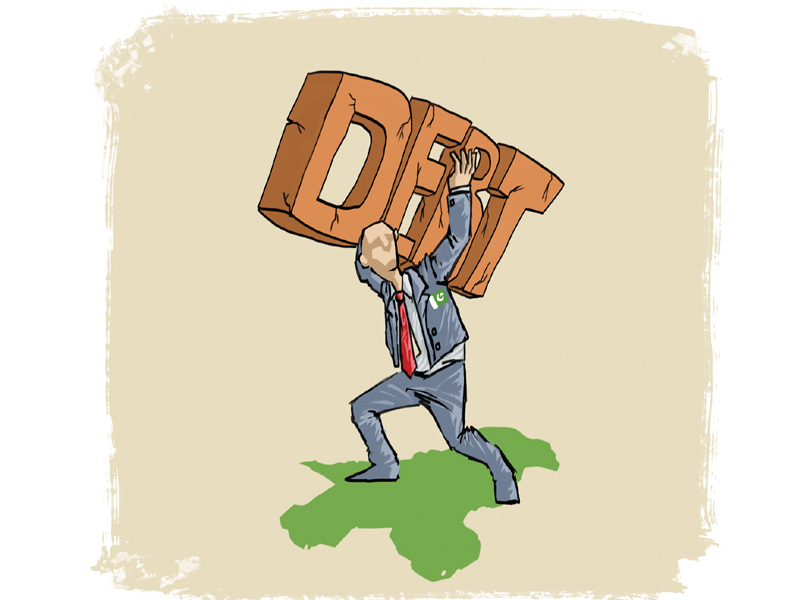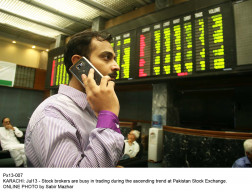
The IMF’s Fiscal Monitor, released from Washington, showed that during the current fiscal year Pakistan’s gross debt to total national output ratio will remain at 63.4%. The projected debt will be higher by 3.4% of Gross Domestic Product (GDP) from the limit determined under the Fiscal Responsibility and Debt Limitation (FRDL) Act of 2006.
The debt projections exclude the $2 billion that Pakistan raised from international markets at exorbitant prices last week.
The government has announced that during the current fiscal year it will reduce the debt to below 60% of GDP as per statutory requirements of the FRDL Act. But trends suggest the government will miss its goal by a wide margin. The federal government has already added over Rs1 trillion in the national debt during the first eight months of the current fiscal year, according to the State Bank of Pakistan data.
The country seems to be trapped in the vicious debt cycle as it is borrowing to retire previous borrowings, further squeezing space for spending on health and education.
The Fiscal Monitor further showed that in the next financial year 2014-15, the debt will remain above the threshold and clock in at 62.4% of GDP.
According to international standards, 60% debt-to-GDP ratio is considered relatively sustainable. But analysts, both independent and of international financial institutions, say that for a developing country like Pakistan 60% ratio is unsustainable.
Successive governments have been living beyond their means and kept heavily borrowing to finance their expenditures. The situation has become so erratic that servicing of debt is now the largest expense of the budget, followed by defence spending.
The government has so far failed to increase revenues and its tax collection fell short of the first nine months’ target by over Rs200 billion.
According to IMF’s second review report of the $6.7-billion programme, the average maturity of total domestic public debt is close to two years and 64% of the debt is due for redemption within the next 12 months, entailing high rollover and refinancing needs.
The Fiscal Monitor has highlighted the same apprehensions. The Monitor showed that Pakistan’s gross finance needs during the current fiscal year will remain at 35.5% of the total national output. In absolute terms, the country needs at least Rs9.2 trillion during the current fiscal year to meet its debt obligations and finance expenditures.
In terms of total size of the economy, Pakistan’s gross financing requirements are second highest in the world, following Egypt whose total financing requirements are estimated at 39.4% for the current Egyptian fiscal year.
However, the government continues to believe that the planned fiscal consolidation of at least 4% of GDP over a period of three years will lower the budget deficit to sustainable levels and, consequently, place the debt-to-GDP ratio on a firmly declining path.
Published in The Express Tribune, April 15th, 2014.
Like Business on Facebook, follow @TribuneBiz on Twitter to stay informed and join in the conversation.
COMMENTS (8)
Comments are moderated and generally will be posted if they are on-topic and not abusive.
For more information, please see our Comments FAQ
1725443747-0/Untitled-design-(5)1725443747-0-405x300.webp)


1724238420-0/Untitled-design-(3)1724238420-0-165x106.webp)













Nawaz league just rearranging the deck chairs on the titanic. The only real leader of pakistan who helped pakistan prosper is on trial. Sooner or later the pakistani people will have to support a government by the establishment with technocrats included. No politicians.
We can loan Pak some money on 12.5% interest,food and water, polio vaccines shall be provided on the condition that people who have cut their foreskin, need to find it and attach it back.
We have 5 years of irresponsible PPP-Z rule to blame for this........and now PML-N is really not helping by taking on more debt......I wonder which government, this or the next, will be left holding the dead carcass.
Last time I looked a bond was considered "debt" ... does this imply your not going to repay?
The nation miss Musharraf for sure - the only leader who cared Pakistan and the people living in.
You will miss Musharraf who got rid of loans and begging. Politicians are doing the opposite.
Woah!! That is hugee!! Pakistan needs to increase tax revenue from 8.5% to 15% unless we manage to do that we will not develop as a nation!